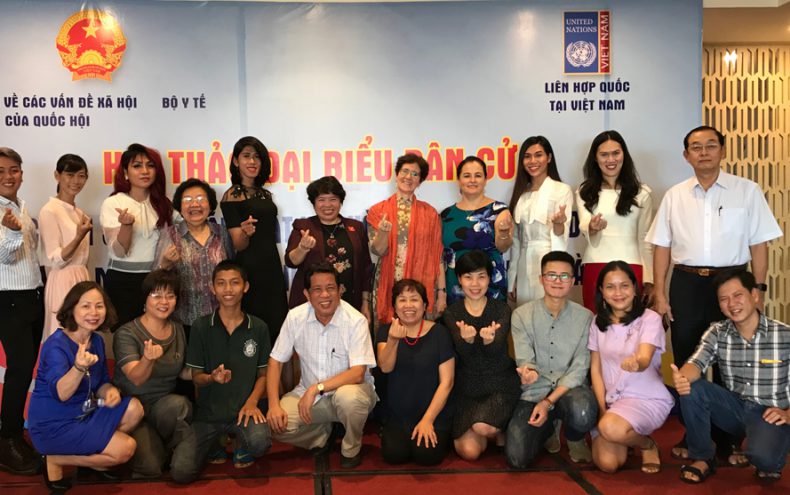Towards Universal Health Coverage in Viet Nam: Meeting the needs of people affected by HIV
Doan Thi Khuyen, from the northern province of Hai Phong in Viet Nam, has been on HIV treatment for several years with good health. She is a community leader in Hai Phong and a member of the Steering Committee of Viet Nam Alliance for Supporting AIDS Treatment Adherence (SATA+). Recently, Khuyen received more request for support from other People living with HIV (PLHV) regarding the transitioning of HIV antiretroviral medicines (ARV) from external donor support to the national social health insurance (SHI) fund. Viet Nam will start providing SHI-funded ARV from January 2019, a major step forward to ensure the sustainability of the national AIDS response but requiring important adaptation for patients, heath facilities and systems.
“Some concerning issues have emerged during the preparations for transitioning [of HIV treatment] to SHI fund,” Khuyen said at a policy dialogue with National Assembly’s Social Affairs Committee and relevant Government authorities on the implementation of HIV legislation in the context of achieving Universal Health Coverage (UHC) in Viet Nam. The policy dialogue was convened in September 2018 by the National Assembly with support from the Joint United Nations Team on HIV.
Community concerns, Khuyen shared, highlight the importance of counselling and support for HIV treatment adherence among people living with HIV newly enrolled in HIV treatment. The provision of this essential support to optimize HIV treatment’s effectiveness is under challenge due to a healthcare workers’ shortage at HIV outpatient clinics (OPCs) affected by external donors’ funds phase-out and integration into public health hospitals for eligibility for SHI payment. Khuyen was called to support PLHIV who stopped taking ARVs because of the medicines’ side-effects led them to believing their health was worsening. Other PLHIV delayed their monthly visits to OPCs to get their ARV because they did not fully understand the need to take them daily which is essential for HIV treatment’s effectiveness and avoiding drug resistance.
Viet Nam has been making enormous efforts in recent years to prepare for the transition of HIV treatment to SHI fund for financial sustainability. The transition process includes three main pillars: the integration and accreditation of HIV Outpatient Clinics for SHI eligibility, the expansion of SHI coverage among people living with HIV on HIV treatment and the procurement and supply of SHI-funded ARVs with quality and optimal prices.
The progress has been impressive. A Prime Minister’s Decision issued in 2016 mandates all provinces to ensure 100% of PLHIV in their localities are enrolled in SHI and to allocate local budget to support with SHI premium and the co-payment for ARV drugs. By mid-2018, more than 85% of PLHIV already on HIV treatment have enrolled in SHI. Most (382 out of 429) Outpatient Clinics have finalized the integration and accreditation processes, and signed contracts with Viet Nam Social Security for providing SHI-funded ARVs. Several other measures have been deployed to facilitate SHI access such as providing support to PLHIV to enrol in and use the SHI, flexibilities for PLHIV lacking proper identity documents, and financial support for PLHIV who cannot afford it. However, some concerns remain as the transition is fast approaching. All stakeholders will continue to work closely together to resolve issues so that every PLHIV can benefit from HIV treatment.
“The HIV response is very much a key component contributing to, as well as a condition, for achieving Universal Health Coverage. This transition toward more financial sustainability through SHI and Outpatient Clinics’ integration is essential but should ensure sustained qualified human resources and services well adapted to the needs of HIV key populations,” said UNAIDS Country Director Ms Marie-Odile Emond.
“The response to HIV including the achievement of the 90-90-90 targets is a priority for Viet Nam in the overall efforts towards UHC”, WHO Representative in Viet Nam Dr Park Kidong affirmed. “Ensuring affordability of health services as well as sufficient capacities at primary health care level is critical. We need to do more to close the gaps.”
A recent WHO assessment of progress towards UHC in the West Asia Region shows that Viet Nam is making encouraging progress towards UHC, with 73% coverage of basic healthcare. However, there is still about 5% households who spent more than 25% of their income on healthcare.
“As per Viet Nam’s constitution, every citizen has the right to healthcare. Our goal is for each and every Vietnamese person especially the vulnerable and poor people, to access the healthcare (s)he needs and without financial burden. This is essential in achieving social progress and equality.” Mme Nguyen Thuy Anh, Chairwoman of the National Assembly Social Affairs Committee emphasized.
In 2017, Viet Nam Communist’s Party Central Committee adopted Resolution 20 affirming the country’s commitment to end AIDS and TB and eliminate malaria by 2030 and ensuring that 95% of the Vietnamese population will be covered by the national health insurance by 2025.




